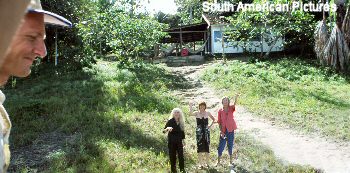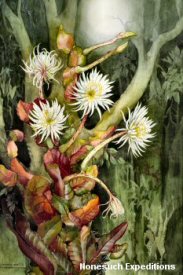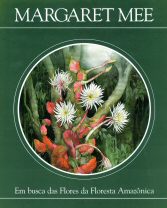| |
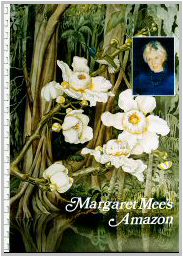 | MARGARET
MEE'S AMAZON | | A
THEME CREATED BY TONY MORRISON | ©
1987 | | | | Margaret
Mee | | Her
life embraced art, politics, the threatened environment and a quest for a very
elusive Amazon flower. Most of all all Margaret was an brilliant story-teller
. |
| and
| The
Amazon Moonflower | Journey
15 — to the Rio Negro, Brasil |
|
| In
Brasil the story is known as | Margaret
Mee e a Flor da Lua | | 'the
flower opens for the first time soon after dusk and closes at dawn - then it dies' | The
rare cactus is now generally known as Selenicereus wittii. The
plant has striking crimson flattened stems that cling to trunks of trees in the
flooded forest and has a limited range possibly extending to some Amazon regions
of Peru and Colombia Margaret
had seen the cactus on two of her early Amazon journeys but only as the reddened,
flattened stems. Then on another trip in 1982 accompanied by Sue Loram a
young British woman who at that time lived in Manaus she found some buds and what
seemed to be an opening flower. "We tried to keep them but they
were so wilted they never revived". To these clues Margaret added
places and dates saying at the same time that nobody she had spoken with had known
much about the flower. Margaret
agreed that Tony should edit her diaries and set-up a filming project to take
her to the Amazon in a search of the flowering. "It will have
to be next year" she said "because I need time to
recover from my hip operation". She had just received a second
replacement hip during a long visit to England . The delay also allowed for her
to divide her notes into 'chapters' and for Tony to discover more about the cactus
flowering period. Over the following six months he approached experts in Brasil
and around the world. Margaret knew Bruce Nelson at INPA* the Amazon research
institute in Manaus and he provided details of five specimens in the official
collection. Reports and advice were culled from other scientists in Britain, Mexico,
Sweden, and Germany. Sue Loram had kept a good account of the flowers she
saw in 1982. Her observations were an essential link as it soon became
clear that many botanical details of the flower, its life and rough area of distribution
were known but the 'window' for the flowering was not so certain.
One eminent correspondent said he thought "'it would be very difficult
to find it flowering in nature". The
focus of most reports seemed to settle on the Rio Negro where Manaus lies on the
northern bank near the confluence with the main Amazon river, the Solimões.
In 1988 Manaus had a population of almost a million and was a major
port. The Rio Negro is the major tributary entering from the north and is immense.
It is 2080kms long and at Manaus is more than 4kms wide. The annual rise
and fall can be as much as 12 meters and the harbour has a famous floating dock
built by British engineers in the first decade of the 20th century. The
Negro gets its name from the clear dark water that is totally different to the
sediment laden brown of the Solimões coming from the west. Without
nutrients the forest, especially those on sandy soil are not so rich. Some
parts are well known for their unique plant diversity and one, the Archipelago
of the Anavilhanas the world's largest freshwater archipelago, is only 8
kms upriver from Manaus | A
Challenge in the Flooded Forest March
1987, Rio de Janeiro, Brasil...
Tony Morrison
was reading Margaret's diaries with a book and television documentary in mind.
He had been following her career for 17 years and had been invited to her house
the old suburb of Santa Teresa high above Botafogo Bay. Margaret
had been in Rio de Janeiro since August 1968 and over the years had filled a pile
of notebooks with records of her Amazon adventures. Each tale she had was wonderfully
descriptive but to become a book or television film the notes needed an ending
. Tony asked Margaret to think of her greatest ambition and without hesitation
she replied that she wanted to paint the flowering of a rare Strophocactus. The
cactus was given its name Strophocactus wittii after a German collector,
N.H Witt who late in the 19th century was a trader in Manaus, a city almost 1600kms
up the Amazon river. The genus has since been renamed Selenicereus after Selene
the ancient Greek personification of the moon as a goddess. For
half the year the river inundates much of the land but when the water level drops
as many as 400 islands dot the river. Margaret
and Sue Loram had been in the Archipelago of the Anavilhanas in April 1982 when
they found buds so that seemed to be the place to start. Also from the point of
view of logistics it could not be better as Margaret knew a young Brasilian, Gilberto
Castro who had a small rustic house on the river bank. Gilberto also owned a boat
that his caretaker or caseiro Paulo used to collect him from Manaus. Margaret
was 78 and with
two replacement hips so a short, well timed trip was not only desirable but essential.
The basic plan had to be simple. Locate the flower. Check the development of the
buds and then take Margaret to the spot for a couple of days. She was very
fit and after fourteen journeys to Amazonia certainly accustomed to the day to
day health hazards. When
Tony returned to London he took the idea to the BBC where old colleagues knew
of his earlier documentary films. The idea of a midnight flowering coupled with
Margaret's long career as an artist produced an immediate and positive response.
The fact that the Amazon forests were either burning, being cut down or often
both at the same time simply added spice to the story.
The project was given the working title of Margaret Mee's Amazon
and a promotional folder of sketches , photos and a written outline was created. While
the idea began to take shape as a televison production Tony was working on the
book for Nonesuch Expeditions and plans for the journey. |  | The
archipelago of the Anavilhanas.  The
green is the forest. The dark blue is the river flowing from right to left across
the picture. The green bands are islands of rock and sand divided by huge areas
of flooded forest or igapós Gilberto's house is on the riverbank
on the right of the picture. The small town of Novo Airão is on the left
on the southern bank of the river inlet at the edge of the image -the Igarapé
Grande The
green is the forest. The dark blue is the river flowing from right to left across
the picture. The green bands are islands of rock and sand divided by huge areas
of flooded forest or igapós Gilberto's house is on the riverbank
on the right of the picture. The small town of Novo Airão is on the left
on the southern bank of the river inlet at the edge of the image -the Igarapé
Grande |
| Suddenly
the plan was changed
Early in December 1987 Tony's phone rang at 8.30 am with a personal call from
the BBC executive producer saying that the project had been given second thoughts.
These were influenced it seems by Margaret's age and the great imponderable -
"what was the chance of finding the flower?" Undeterred
Tony talked with a friend in the National Geographic Society, Washington and Steve
Burns a producer was sent to Rio de Janeiro to meet Margaret and shoot a test.
This attempt also met a dead-end just when time was closing for the small team
to confirm arrangements especially for the cameraman / director Brian Sewell who
was busy with a different international television company every day. So few choices
were available and Tony decided to fund a 'pilot project' from a television
production account he held with his wife Marion and support from Nonesuch Expeditions.
Early
in 1988
Tony met with
Gilberto Castro in Rio de Janeiro for some quick thinking as there had to be no
mistake. No lost chances would ever be forgiven. They concluded that the 'window'
had to be sometime after late April and Gilberto arranged that Paulo would make
regular trips into the flooded forest and report back to Rio de Janeiro via telephone
as soon as the buds began to develop. The difficult bit would be judging how long
the development would take. Experts had pointed out that the buds formed on the
edges of the stem and grew to form a narrow tube about 12cms long. The flower
developed at the end of the tube and opened when triggered by dusk. Several
buds on a single plant could react in different ways and while cultivated hothouse
plants were known, there was no telling what would happen in the forest of the
Rio Negro George
Clarke MBE [Member of the British Empire] the British Consul in Manaus
and a long time friend of Tony's was alerted particularly in the event that medical
help was needed for Margaret and the team was put on standby. |
| The
Team | 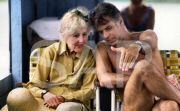 Margaret
Mee [left] Amazon traveller with 14 journeys to her credit totalling about
three years on Amazonian rivers. and Gilberto Castro, Brasilian businessman
and conservationist with a passion for the outdoors. He was a member of a Camel
Trophy team. Margaret
Mee [left] Amazon traveller with 14 journeys to her credit totalling about
three years on Amazonian rivers. and Gilberto Castro, Brasilian businessman
and conservationist with a passion for the outdoors. He was a member of a Camel
Trophy team. | |
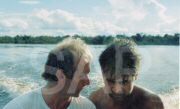 Gilberto
Castro [right] and Tony Morrison, Writer and film-maker. Tony studied
Zoology at university and began travelling in South America in 1961. He had already
travelled extensively in western Amazonia - in Peru and Bolivia and been far along
the Rio Negro and its tributary the Rio Branco. Photo:Brian
Sewell / South American Pictures Gilberto
Castro [right] and Tony Morrison, Writer and film-maker. Tony studied
Zoology at university and began travelling in South America in 1961. He had already
travelled extensively in western Amazonia - in Peru and Bolivia and been far along
the Rio Negro and its tributary the Rio Branco. Photo:Brian
Sewell / South American Pictures | | | | |
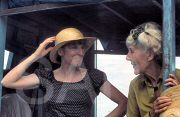 Margaret
Mee Margaret
Mee [right] and Sue
Loram. Originally from Britain Sue first arrived in Manaus via South Africa,
Buenos Aires and Rio de Janeiro to INPA [*] Manaus. By 1988 Sue was back in Rio
de Janeiro as a partner in a specialist restaurant | | 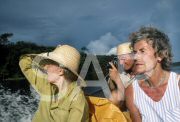 Margaret
Mee [left] and Sally Duchess of Westminster. Sally
Westminster Widow of the Fourth Duke of Westminster had been a friend of
Margaret's since the late 1960s. They travelled to the Rio Negro together in 1975 Margaret
Mee [left] and Sally Duchess of Westminster. Sally
Westminster Widow of the Fourth Duke of Westminster had been a friend of
Margaret's since the late 1960s. They travelled to the Rio Negro together in 1975 |
| | | |
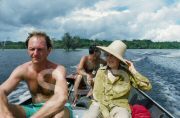 Margaret
Mee [right] and Brian Sewell who was from Britain and had made Rio
de Janeiro his home. As an immensely experienced cameraman-director he had worked
for most of the world's major television companies. Since 1976 he had covered
Brasil from end to end. Margaret
Mee [right] and Brian Sewell who was from Britain and had made Rio
de Janeiro his home. As an immensely experienced cameraman-director he had worked
for most of the world's major television companies. Since 1976 he had covered
Brasil from end to end. | |
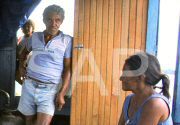 Paulo
Saldanha and his wife Maria. Paulo was Gilberto's caseiro /
caretaker at his house beside the Rio Negro. For Paulo the river was his home
street. He knew it like the back of his hand Paulo
Saldanha and his wife Maria. Paulo was Gilberto's caseiro /
caretaker at his house beside the Rio Negro. For Paulo the river was his home
street. He knew it like the back of his hand | | | | |
| Behind
the scenes others helped with communications including George Clarke
in Manaus and David Lorimer who was born in Manaus and lived in Santos
on the Brasilian coast - another long time friend of Tony and Marion. Marion
Morrison in Britain knew all the locations from past travels and controlled
the plan from her desk. The
New Plan "We will fly everyone from Rio de Janeiro to Manaus
a city of almost a million. That's four hours in the air. Then they stay overnight
or perhaps two in a simple hotel. Then using Gilberto's boat they will travel
up the Negro to the house. That's about a nine hour journey and we can make Margaret
comfortable in a hammock. The accommodation at the house is simple. Hammocks,
mosquito nets, a bottled gas cooker, a toilet and there is even a shower heated
by solar energy. But they will be out of touch. There's no 'phone or two-way radio.
A couple of smaller and faster boats will be needed for searching the igapos".. All
the expenses together with some special fees for the team apart from Sally Westminster's
air fares were covered by the project budget. Now all that was needed was to confirm
the important date. Flights were booked and second and some third fall back reservations
were made. Early in the year Paulo made a list of trees where he had seen plants
and towards the end of April he went to investigate. In mid April he reported
to Gilberto that the buds were almost fully developed. As it had taken him a day
to search and another day to get to a 'phone in Manaus it seemed that the Plan
was 'on'. Gilberto
took a flight to Manaus to prepare the boat and stores. Sally Westminster arrived
in Rio de Janeiro on an overnight flight direct from London and was met at Galeão
the international airport by Sue and Margaret. They had time for a quick cafezinho
- small sweet coffee before getting the first flight of the day to Manaus. They
were met at the airport by Gilberto and George Clarke. Tony and Brian who had
been filming in Rio followed on yet another flight with all the camera gear. In
Manaus the team stayed in the Hotel Imperial not far from the extraordinary Teatro
Amazonas a relic of the 19th century 'rubber boom'. 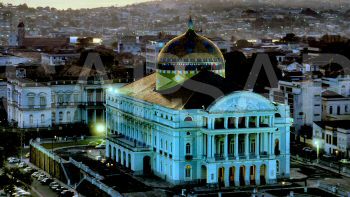 As
they settled in the hotel more news came in about the flowers. The buds were growing
quickly and Gilberto set the departure time for 9.15 the next day. The final plans
were laid over a supper at one of George Clarke's favourite restaurants, La
Barca on the outskirts of the city. La Barca specialised in Amazon river fish
and was a popular place. The team was introduced to George's wife and Bruce Nelson
a long time friend of Margaret and Sue. Tropical rain rattled on the roof for
most of the meal and the party returned to the hotel at 10.30 and after a deciding
about the plans for the morning everyone except Tony and Margaret headed for some
rest. "It just has to be be right this time... it just has to
be....". They chatted long into the night. As
they settled in the hotel more news came in about the flowers. The buds were growing
quickly and Gilberto set the departure time for 9.15 the next day. The final plans
were laid over a supper at one of George Clarke's favourite restaurants, La
Barca on the outskirts of the city. La Barca specialised in Amazon river fish
and was a popular place. The team was introduced to George's wife and Bruce Nelson
a long time friend of Margaret and Sue. Tropical rain rattled on the roof for
most of the meal and the party returned to the hotel at 10.30 and after a deciding
about the plans for the morning everyone except Tony and Margaret headed for some
rest. "It just has to be be right this time... it just has to
be....". They chatted long into the night. Departure
at last
Gilberto and Paulo had prepared the boat the day before and all that was remained
to be done was some last minute buying in the market. Sue had a secret recipe
she intended to try as a celebration 'if the search is successful' she promised | | |  | Margaret
Mee and Sue Loram look back to Manaus as the boat heads upriver | The
team leaves the hotel. Gilberto Castro is by the door of the VW microvan and Sue
Loram is on the right | 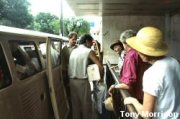 | | | The
nine hour river journey to the house was passed reading, sleeping and talking | 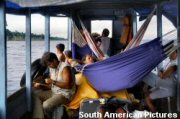 |
| | | | The
search
Paulo
had located several trees with the cactus spread on the trunks. The first day
began with rain that cleared by 8.30am. The first tree had a plant without flowers,
but two more about 45 minutes away from the house had one opened, one wilted flower
and two close to opening. Now the question was how many days to opening. One,
two or three days was the best guess from the scientific data they had been given
so while looking for more plants the decision was taken to try again in 24 hours
time. Back at the house Sue was in charge of the kitchen and Sally Westminster
took over the chores including washing the dishes. Supper was pacu a local
river fish cooked in coconut milk, one of Sue's specialities. | | |
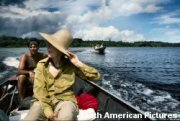 Gilberto
Castro and Margaret Mee are followed by his friends Alfredo and Gloria
Norris. They helped on the first day of the search Gilberto
Castro and Margaret Mee are followed by his friends Alfredo and Gloria
Norris. They helped on the first day of the search | |
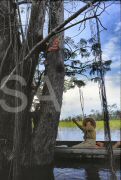 The
first plant found by Paulo Saldanha was too high above the water level. The
crimson flattened stems were at least 10 feet 3 m above the water. Photo: Brian
Sewell for South American Pictures The
first plant found by Paulo Saldanha was too high above the water level. The
crimson flattened stems were at least 10 feet 3 m above the water. Photo: Brian
Sewell for South American Pictures |
| | | |
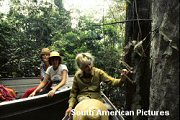 Sally
Westminster[behind], Sue Loram and Margaret Mee find buds in the shade
of one of the igapós - the flooded forest Sally
Westminster[behind], Sue Loram and Margaret Mee find buds in the shade
of one of the igapós - the flooded forest | |
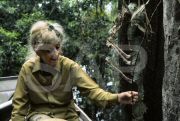 Margaret
Mee takes a close look at some buds but they were tightly closed and the place
was dark Margaret
Mee takes a close look at some buds but they were tightly closed and the place
was dark | | |
| The
only plant with good light and close to a main waterway / parana was still
too high for Margaret Mee to see clearly. Gilberto's boat was used as a floating
studio and he lifted Margaret to the roof so she could sketch. While travelling
great care had to be taken not to spill food, oil or any other contaminents in
the water Photo Brian Sewell / South American Pictures |
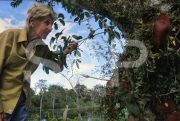 Margaret
Mee standing on the roof looks at the buds to try and select the area she
would record in her sketchbook Margaret
Mee standing on the roof looks at the buds to try and select the area she
would record in her sketchbook | |
 From
a garden chair and with a sketchbook on resting on knee Margaret made meticulous
notes of the shape and colour of the plant From
a garden chair and with a sketchbook on resting on knee Margaret made meticulous
notes of the shape and colour of the plant |
| The
painting Twenty four hours later the boat was loaded with enough food
for a couple of days, some blankets and all the film gear. Forty five minutes
later and the team was alongside the tree and prepared for dusk. The daylight
to dusk change was tropically quick and just as dramatically the flower began
to open. The team crowded on to the roof of the boat totally spellbound. The white
to pale yellow perianth leaves looking like petals unfurled and one or two seemed
to 'click' as they gained freedom. As the filming lights were turned on and Margaret
began sketching the flower stopped opening. The light had interrupted the mechanism
so lower powered hand held battery lights were tried and the flower continued
to open. It was more difficult for Brian but Margaret could see her sketchpad.
The light from an almost full moon helped everyone to move around.
|  Margaret
Mee sketched the opening flower by the light of hand held torches Margaret
Mee sketched the opening flower by the light of hand held torches | |
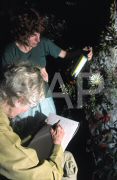 All
the stages of the opening and closing were sketched. Details of the colours had
to wait until daylight All
the stages of the opening and closing were sketched. Details of the colours had
to wait until daylight | | | | |
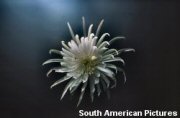 By
midnight the flower was fully open By
midnight the flower was fully open | |
 Sue
Loram and Gilberto Castro are entranced Sue
Loram and Gilberto Castro are entranced |
| | | |
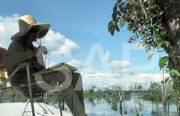 The
flower had wilted and all she needed were the colours of the flattened stems and
details of the the unopened buds The
flower had wilted and all she needed were the colours of the flattened stems and
details of the the unopened buds | |
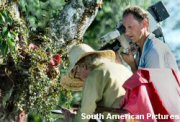 Brian
filmed Margaret Mee while she sketched the plant in daylight. Brian
filmed Margaret Mee while she sketched the plant in daylight. |
| |
 The
sketch was made 'by eye' and Margaret had the technical skill to keep the proportions
exact. The plants was not touched, measured or handled in any way The
sketch was made 'by eye' and Margaret had the technical skill to keep the proportions
exact. The plants was not touched, measured or handled in any way | |
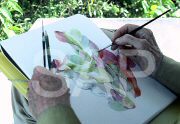 After
making the outline Margaret Mee then used water based colour to match the
shades of the plant. Once again she had perfected the skill to use her 'eye' for
comparing the delicate tones After
making the outline Margaret Mee then used water based colour to match the
shades of the plant. Once again she had perfected the skill to use her 'eye' for
comparing the delicate tones | |
| Margaret
sketched through the night She finished work
at 3am but none of the team had any sleep. The dawn was coming. With the light
the perianth leaves began to close and by 8am the flower had wilted. The flower
had lived up to its name of Selenicereus. The
Moonflower is named On
the return journey from the final painting trip Tony, Margaret and Sally chatted
about the book and the cover. A deadline loomed for the book and it was decided
that Tony would write the story as Journey Fifteen in Margaret's style
while she painted the artwork for the cover . They decided that the painting needed
certain elements: the flower, the forest and the moon. These elements
had to be set within the page to allow for space for the title. "You
must call it 'The Moonflower'" said Sally. "It's the only
title. Especially after last night". WATCH
THE VIDEO After
some discussion about other night flowering cacti the title became 'In Search
of the Amazon Moonflower' and the final artwork was left in Margaret's hands. So
success at last. Back at the house it was time for champagne and the special treat
made by Sue from cupuaçu a delicious tropical fruit she had 'smuggled'
aboard from the market in Manaus . "I knew we would have something to celebrate."
It was close to Margaret's 79th birthday. The next day the team began to go their
separate ways. Margaret, Sue and Sally remained at the house for a
few days more perhaps accepting that it could be their last visit.
| |
|
Brian Sewell waves a goodbye to Margaret, Sue and Sally Westminster |
Paulo took
Gilberto, Tony and Brian to Manaus. They arrived in the port at 10pm and Brian
caught the first flight to Rio de Janeiro. Tony took a midnight flight to São
Paulo from where messages about the success were sent around the world. Sue
Loram, Margaret and Sally Westminster stayed a couple of extra days at Gilberto's
house. They visited the nearby igapós and Sue and Margaret paddled
a small canoe to the place where they had found a Selenicereus / 'Moonflower'
cactus six years earlier. Sally
Westminster had to return to London and Margaret and Sue wanted to spend a few
more days in the forest. The three friends asked Paulo to take them downriver
to Manuas where Sally could catch a flight, firstly to Brasilia the capital to
stay overnight with the British Ambassador and his wife before heading for home
via Rio de Janeiro. Sue, Margaret and Paulo went back to the port and began their
journey upstream Back
in Rio de Janeiro By lucky coincidence Sally Westminster arrived from
Brasilia at Rio's Galeão International Airport as Tony was leaving for
London. They had time for a cafezinho - coffee and brief swap of memories.
Margaret and Sue arrived a few days later and went their separate ways to work.
Margaret with Greville working on the composition began a rough sketch for the
cover of the book. The placing of the flowers, the moon and water had to allow
for the title and credits. Greville with his experience as a commercial artist
knew exactly what was required. The 'rough' was sent to Tony for approval before
Margaret began work on the painting but all was well. The composition was just
as they had planned and Margaret began the final painting in June. Margaret
finished the Moonflower in her studio in Rio de Janeiro and it was carried by
hand to London and arrived on July 5th.
| The
Amazon Moonflower |
 |
The
rough sketch, unsigned, on Fabriano 2 paper June
1988 | | |
|
| Presented
by courtesy of Nonesuch Expeditions and South American Pictures | | | Epilogue | The
book In Search of Flowers of the Amazon Forests was published in November
1988. The Amazon Moonflower was dropped as a title and cover in favour of one
of Margaret's classic paintings. Sally Westminster was indignant. "The title
and the magic of that moment will never be repeated". Tony
edited the book and wrote the linking notes as well as the biographical introduction
' Before the Amazon' . Using her style and with her approval he wrote Journey
Fifteen - The Moonflower. Margaret
died in a car accident in England only two weeks after the book was published
and her memory lives on with the goodwill to fund scholars and research. The Royal
Botanic Gardens, Kew near London maintain a Margaret Mee Fellowship office. In
Rio de Janeiro there is a Society of Friends of Margaret Mee and occasionally
it runs a memorial journey to Anavilhanas. |
| Brasil
1989 - A year after her death | | |
| Em
busca das Flores da Floresta Amazônica |
| A
Portuguese translation of the original book published in Rio de Janeiro by Salamandra
Consultoria Editorial S/A. The Moonflower is featured on the jacket cover
| |
| *
INPA Instituto Nacional de Pesquisas da Amazônia - Brasil's famed
National Institute of Amazon Research, Manaus FBMM
Fundação Botânica Margaret Mee, The Margaret Mee Foundation,
Rio de Janeiro [1988-2008] now the Society of Friends of Margaret Mee] |
|
|
| The
text and most of the images are © Copyright |
| For
any commercial use please contact | | |
| THE
NONESUCH - FLOWER OF BRISTOL |
| AN
EMBLEM FOR ENTERPRISE | | |
|
|
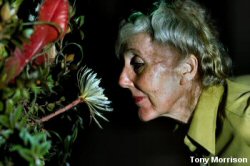


 The
green is the forest. The dark blue is the river flowing from right to left across
the picture. The green bands are islands of rock and sand divided by huge areas
of flooded forest or igapós Gilberto's house is on the riverbank
on the right of the picture. The small town of Novo Airão is on the left
on the southern bank of the river inlet at the edge of the image -the Igarapé
Grande
The
green is the forest. The dark blue is the river flowing from right to left across
the picture. The green bands are islands of rock and sand divided by huge areas
of flooded forest or igapós Gilberto's house is on the riverbank
on the right of the picture. The small town of Novo Airão is on the left
on the southern bank of the river inlet at the edge of the image -the Igarapé
Grande Margaret
Mee [left] Amazon traveller with 14 journeys to her credit totalling about
three years on Amazonian rivers. and Gilberto Castro, Brasilian businessman
and conservationist with a passion for the outdoors. He was a member of a Camel
Trophy team.
Margaret
Mee [left] Amazon traveller with 14 journeys to her credit totalling about
three years on Amazonian rivers. and Gilberto Castro, Brasilian businessman
and conservationist with a passion for the outdoors. He was a member of a Camel
Trophy team. Gilberto
Castro [right] and Tony Morrison, Writer and film-maker. Tony studied
Zoology at university and began travelling in South America in 1961. He had already
travelled extensively in western Amazonia - in Peru and Bolivia and been far along
the Rio Negro and its tributary the Rio Branco. Photo:Brian
Sewell / South American Pictures
Gilberto
Castro [right] and Tony Morrison, Writer and film-maker. Tony studied
Zoology at university and began travelling in South America in 1961. He had already
travelled extensively in western Amazonia - in Peru and Bolivia and been far along
the Rio Negro and its tributary the Rio Branco. Photo:Brian
Sewell / South American Pictures Margaret
Mee [right] and Sue
Loram. Originally from Britain Sue first arrived in Manaus via South Africa,
Buenos Aires and Rio de Janeiro to INPA [*] Manaus. By 1988 Sue was back in Rio
de Janeiro as a partner in a specialist restaurant
Margaret
Mee [right] and Sue
Loram. Originally from Britain Sue first arrived in Manaus via South Africa,
Buenos Aires and Rio de Janeiro to INPA [*] Manaus. By 1988 Sue was back in Rio
de Janeiro as a partner in a specialist restaurant Margaret
Mee [left] and Sally Duchess of Westminster. Sally
Westminster Widow of the Fourth Duke of Westminster had been a friend of
Margaret's since the late 1960s. They travelled to the Rio Negro together in 1975
Margaret
Mee [left] and Sally Duchess of Westminster. Sally
Westminster Widow of the Fourth Duke of Westminster had been a friend of
Margaret's since the late 1960s. They travelled to the Rio Negro together in 1975 Margaret
Mee [right] and Brian Sewell who was from Britain and had made Rio
de Janeiro his home. As an immensely experienced cameraman-director he had worked
for most of the world's major television companies. Since 1976 he had covered
Brasil from end to end.
Margaret
Mee [right] and Brian Sewell who was from Britain and had made Rio
de Janeiro his home. As an immensely experienced cameraman-director he had worked
for most of the world's major television companies. Since 1976 he had covered
Brasil from end to end. Paulo
Saldanha and his wife Maria. Paulo was Gilberto's caseiro /
caretaker at his house beside the Rio Negro. For Paulo the river was his home
street. He knew it like the back of his hand
Paulo
Saldanha and his wife Maria. Paulo was Gilberto's caseiro /
caretaker at his house beside the Rio Negro. For Paulo the river was his home
street. He knew it like the back of his hand As
they settled in the hotel more news came in about the flowers. The buds were growing
quickly and Gilberto set the departure time for 9.15 the next day. The final plans
were laid over a supper at one of George Clarke's favourite restaurants, La
Barca on the outskirts of the city. La Barca specialised in Amazon river fish
and was a popular place. The team was introduced to George's wife and Bruce Nelson
a long time friend of Margaret and Sue. Tropical rain rattled on the roof for
most of the meal and the party returned to the hotel at 10.30 and after a deciding
about the plans for the morning everyone except Tony and Margaret headed for some
rest. "It just has to be be right this time... it just has to
be....". They chatted long into the night.
As
they settled in the hotel more news came in about the flowers. The buds were growing
quickly and Gilberto set the departure time for 9.15 the next day. The final plans
were laid over a supper at one of George Clarke's favourite restaurants, La
Barca on the outskirts of the city. La Barca specialised in Amazon river fish
and was a popular place. The team was introduced to George's wife and Bruce Nelson
a long time friend of Margaret and Sue. Tropical rain rattled on the roof for
most of the meal and the party returned to the hotel at 10.30 and after a deciding
about the plans for the morning everyone except Tony and Margaret headed for some
rest. "It just has to be be right this time... it just has to
be....". They chatted long into the night.


 Gilberto
Castro and Margaret Mee are followed by his friends Alfredo and Gloria
Norris. They helped on the first day of the search
Gilberto
Castro and Margaret Mee are followed by his friends Alfredo and Gloria
Norris. They helped on the first day of the search The
first plant found by Paulo Saldanha was too high above the water level. The
crimson flattened stems were at least 10 feet 3 m above the water. Photo: Brian
Sewell for South American Pictures
The
first plant found by Paulo Saldanha was too high above the water level. The
crimson flattened stems were at least 10 feet 3 m above the water. Photo: Brian
Sewell for South American Pictures Sally
Westminster[behind], Sue Loram and Margaret Mee find buds in the shade
of one of the igapós - the flooded forest
Sally
Westminster[behind], Sue Loram and Margaret Mee find buds in the shade
of one of the igapós - the flooded forest Margaret
Mee takes a close look at some buds but they were tightly closed and the place
was dark
Margaret
Mee takes a close look at some buds but they were tightly closed and the place
was dark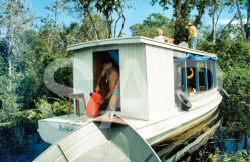
 Margaret
Mee standing on the roof looks at the buds to try and select the area she
would record in her sketchbook
Margaret
Mee standing on the roof looks at the buds to try and select the area she
would record in her sketchbook From
a garden chair and with a sketchbook on resting on knee Margaret made meticulous
notes of the shape and colour of the plant
From
a garden chair and with a sketchbook on resting on knee Margaret made meticulous
notes of the shape and colour of the plant Margaret
Mee sketched the opening flower by the light of hand held torches
Margaret
Mee sketched the opening flower by the light of hand held torches All
the stages of the opening and closing were sketched. Details of the colours had
to wait until daylight
All
the stages of the opening and closing were sketched. Details of the colours had
to wait until daylight  By
midnight the flower was fully open
By
midnight the flower was fully open Sue
Loram and Gilberto Castro are entranced
Sue
Loram and Gilberto Castro are entranced The
flower had wilted and all she needed were the colours of the flattened stems and
details of the the unopened buds
The
flower had wilted and all she needed were the colours of the flattened stems and
details of the the unopened buds Brian
filmed Margaret Mee while she sketched the plant in daylight.
Brian
filmed Margaret Mee while she sketched the plant in daylight.  The
sketch was made 'by eye' and Margaret had the technical skill to keep the proportions
exact. The plants was not touched, measured or handled in any way
The
sketch was made 'by eye' and Margaret had the technical skill to keep the proportions
exact. The plants was not touched, measured or handled in any way After
making the outline Margaret Mee then used water based colour to match the
shades of the plant. Once again she had perfected the skill to use her 'eye' for
comparing the delicate tones
After
making the outline Margaret Mee then used water based colour to match the
shades of the plant. Once again she had perfected the skill to use her 'eye' for
comparing the delicate tones